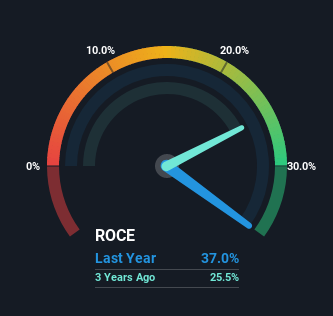- Hong Kong
- /
- Metals and Mining
- /
- SEHK:2798
Perennial Energy Holdings (HKG:2798) Will Be Hoping To Turn Its Returns On Capital Around
Did you know there are some financial metrics that can provide clues of a potential multi-bagger? Ideally, a business will show two trends; firstly a growing return on capital employed (ROCE) and secondly, an increasing amount of capital employed. Basically this means that a company has profitable initiatives that it can continue to reinvest in, which is a trait of a compounding machine. So while Perennial Energy Holdings (HKG:2798) has a high ROCE right now, lets see what we can decipher from how returns are changing.
Understanding Return On Capital Employed (ROCE)
For those that aren't sure what ROCE is, it measures the amount of pre-tax profits a company can generate from the capital employed in its business. To calculate this metric for Perennial Energy Holdings, this is the formula:
Return on Capital Employed = Earnings Before Interest and Tax (EBIT) ÷ (Total Assets - Current Liabilities)
0.37 = CN¥919m ÷ (CN¥3.7b - CN¥1.2b) (Based on the trailing twelve months to June 2022).
Therefore, Perennial Energy Holdings has an ROCE of 37%. In absolute terms that's a great return and it's even better than the Metals and Mining industry average of 13%.
View our latest analysis for Perennial Energy Holdings

Historical performance is a great place to start when researching a stock so above you can see the gauge for Perennial Energy Holdings' ROCE against it's prior returns. If you'd like to look at how Perennial Energy Holdings has performed in the past in other metrics, you can view this free graph of past earnings, revenue and cash flow.
What Can We Tell From Perennial Energy Holdings' ROCE Trend?
On the surface, the trend of ROCE at Perennial Energy Holdings doesn't inspire confidence. Historically returns on capital were even higher at 47%, but they have dropped over the last five years. However, given capital employed and revenue have both increased it appears that the business is currently pursuing growth, at the consequence of short term returns. If these investments prove successful, this can bode very well for long term stock performance.
On a related note, Perennial Energy Holdings has decreased its current liabilities to 33% of total assets. That could partly explain why the ROCE has dropped. Effectively this means their suppliers or short-term creditors are funding less of the business, which reduces some elements of risk. Some would claim this reduces the business' efficiency at generating ROCE since it is now funding more of the operations with its own money.
The Key Takeaway
While returns have fallen for Perennial Energy Holdings in recent times, we're encouraged to see that sales are growing and that the business is reinvesting in its operations. These growth trends haven't led to growth returns though, since the stock has fallen 65% over the last three years. As a result, we'd recommend researching this stock further to uncover what other fundamentals of the business can show us.
Since virtually every company faces some risks, it's worth knowing what they are, and we've spotted 2 warning signs for Perennial Energy Holdings (of which 1 is a bit concerning!) that you should know about.
If you'd like to see other companies earning high returns, check out our free list of companies earning high returns with solid balance sheets here.
New: Manage All Your Stock Portfolios in One Place
We've created the ultimate portfolio companion for stock investors, and it's free.
• Connect an unlimited number of Portfolios and see your total in one currency
• Be alerted to new Warning Signs or Risks via email or mobile
• Track the Fair Value of your stocks
Have feedback on this article? Concerned about the content? Get in touch with us directly. Alternatively, email editorial-team (at) simplywallst.com.
This article by Simply Wall St is general in nature. We provide commentary based on historical data and analyst forecasts only using an unbiased methodology and our articles are not intended to be financial advice. It does not constitute a recommendation to buy or sell any stock, and does not take account of your objectives, or your financial situation. We aim to bring you long-term focused analysis driven by fundamental data. Note that our analysis may not factor in the latest price-sensitive company announcements or qualitative material. Simply Wall St has no position in any stocks mentioned.
About SEHK:2798
Perennial Energy Holdings
An investment holding company, engages in the exploration and mining of coking coal in the People’s Republic of China.
Mediocre balance sheet and slightly overvalued.
Market Insights
Community Narratives



